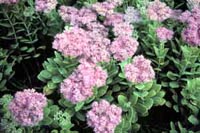Resource Library
Plant of the Week: Stonecrop (Autumn Joy Sedum, Live-for-Ever)
The University of Arkansas System Division of Agriculture does not promote, support or recommend plants featured in "Plant of the Week." Please consult your local Extension office for plants suitable for your region.
Plant of the Week
Autumn Joy Sedum, Live-for-Ever, Stonecrop
Latin: Sedum spectabile 'Autumn Joy'

Fall brings a new assortment of perennial plants into bloom in the garden, and of
these, few are more dependable and indestructible than Autumn Joy Sedum.
While it is a bulletproof survivor in the garden, it is not the least bit invasive
or prone to crowd out its neighbors. Sedums are a member of the stonecrop family which
is uniquely adapted to survive in shallow, dry soils.
Autumn Joy grows up to 18 inches tall from a dense crown of shoots that emerge in
early spring and look like a nest of crowded fledglings each stretching their neck
to get the next worm. The stems are thick and strong and hold aloft the considerable
weight of the 3-inch long, fleshy, gray-green leaves and the 4- to 6-inch wide cluster
of flowers that appear in late summer.
The flowers, as they first begin to appear in mid summer, give the impression of
a head of silvery green broccoli. Opening flower buds produce a mass of half-inch,
five-petaled blooms in the shape of a sharp-pointed star. The flowers start out light
pink and change to a cherry red by the time they are in full bloom. This floral display
is a progressive event with the plants blooming for about eight weeks. With such an
extended blooming period, they are a favorite with butterflies.
But once blooms are over, don’t be in a hurry to remove the tops of the plants. The
strong stems hold the spent flower heads aloft all winter long and create a pleasing
mass of natural dried flower heads. In snowy climates these flower stems create a
pleasing effect all winter long as small roofs of snow accumulate on the head.
I find no mention of Autumn Joy’s origins in my reference material. It was introduced
under three names, with the original name being the German name "Herbstfreude." Wayside
Gardens, the firm that introduced many of us to the finest garden perennials, does
not list it in their 1949 catalog, but lists it as "Indian Chief" in their 1959 catalog.
My Wayside collection is incomplete in the 50s, but I suspect it came to America in
the early 50s as some of that nation’s superior perennials made their way to our gardens.
The plant appears to be a hybrid with the closely related species, S. telephium.
Commercially Autumn Joy is propagated by spring cuttings. A more interesting approach
to propagation is to cut the fleshy stems in the fall and lay them horizontally in
a sunny window. In a month or so, each leaf node will produce a shoot that can be
removed and rooted.
By: Gerald Klingaman, retired
Extension Horticulturist - Ornamentals
Extension News - September 24, 1999
The University of Arkansas System Division of Agriculture does not maintain lists of retail outlets where these plants can be purchased. Please check your local nursery or other retail outlets to ask about the availability of these plants for your growing area.